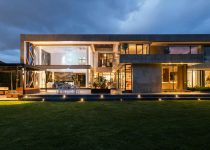How Do I Use Shadows to Enhance Landscape Lighting?
Using shadows effectively can transform your landscape lighting from ordinary to captivating. By understanding how light interacts with different elements in your yard, you can create depth and intrigue. It's not just about illuminating spaces; it's about crafting an atmosphere. Want to know how to achieve the perfect balance and highlight your outdoor features? Let's explore the techniques that can elevate your landscape and evoke the desired mood.
Key Takeaways
- Utilize lower-angle lighting to create longer shadows that enhance the textures and drama of your landscape features.
- Incorporate spotlights to emphasize focal points, casting shadows that add depth and intrigue to the area.
- Experiment with uplighting to reveal tree canopies and architectural details, creating striking shadows that highlight unique elements.
- Balance lighting intensity to avoid glare, ensuring shadows contribute to a harmonious and inviting atmosphere.
- Use diffused lighting techniques to create soft shadows, promoting a calm and serene outdoor environment ideal for relaxation.
Understanding the Basics of Light and Shadow
Understanding the basics of light and shadow is crucial for effective landscape lighting. Light creates illumination, while shadows add depth and dimension.
When you position lights strategically, you can highlight your landscape's features, such as trees, pathways, and architectural elements. Pay attention to the angle of your light sources; lower angles produce longer shadows, enhancing textures and adding drama. Conversely, higher angles result in shorter shadows, creating a softer effect.
Experiment with different placements to see how shadows interact with your space. Remember, too much light can wash out details, so balance is key.
Choosing the Right Lighting Fixtures
When selecting the right lighting fixtures for your landscape, consider how each type complements your design goals and enhances the overall ambiance.
You'll find various options, such as path lights, spotlights, and wall sconces, each serving a unique purpose. Path lights create a welcoming atmosphere while guiding guests safely, whereas spotlights can highlight specific features like trees or sculptures, adding depth through shadows.
Choose fixtures with adjustable brightness and color temperatures to tailor the effects to your preferences.
Additionally, think about materials and finishes that match your landscape style—whether it's rustic, modern, or traditional.
Finally, ensure that the fixtures are durable and weather-resistant, providing long-lasting beauty and functionality in your outdoor space.
Strategic Placement of Lights
To create a captivating landscape, it's essential to strategically place your lights, ensuring they highlight key features while enhancing the overall atmosphere.
Start by identifying focal points like trees, pathways, or water features. Position your lights at varying heights to create depth and texture. For instance, placing lights low to the ground can cast dramatic shadows on nearby surfaces, adding intrigue.
Consider the direction of the light; an upward angle can reveal the beauty of tree canopies, while downlighting can mimic moonlight, creating a serene effect.
Avoid overly bright lights that can cause glare. Remember, balance is key—distribute your lighting evenly to prevent any harsh contrasts, ensuring every element of your landscape shines harmoniously in the night.
Highlighting Architectural Features
While illuminating your landscape, don't overlook the importance of highlighting architectural features. You can draw attention to your home's unique elements by strategically placing lights. Use uplighting to accentuate columns, arches, or textured walls. This technique creates striking shadows that enhance the building's character while adding depth to your outdoor space.
Consider using downlighting to illuminate pathways or garden beds near architectural features, directing the eye toward these focal points. You might also experiment with color filters to match your home's palette, providing a cohesive look.
Creating Mood and Atmosphere With Shadows
Shadows play a crucial role in creating mood and atmosphere in your landscape lighting design. By strategically placing lights, you can cast shadows that evoke feelings of warmth, mystery, or tranquility. For example, soft shadows can create an inviting space for gatherings, while sharp contrasts can add drama to your garden.
Here's a simple table to help you visualize the effects of different shadow techniques:
| Shadow Type | Mood Created | Best Use Case |
|---|---|---|
| Soft Shadows | Warm and Inviting | Dining areas |
| Sharp Shadows | Dramatic and Bold | Sculptures or focal points |
| Diffused Shadows | Calm and Serene | Relaxation zones |
Experiment with these techniques to enhance your outdoor space and create the desired atmosphere.
Frequently Asked Questions
What Types of Lights Are Best for Creating Shadows?
To create shadows effectively, you'll want to use focused spotlights or directional fixtures. These lights cast sharp, defined shadows, adding depth and drama to your landscape. Experiment with placement to achieve the desired effect.
How Can I Control the Intensity of Shadows?
To control shadow intensity, adjust the light's distance and angle. Closer lights create sharper shadows, while further placements soften them. Experiment with different positions until you achieve the desired effect for your landscape.
Are There Specific Colors That Enhance Shadows?
Yes, specific colors can enhance shadows. Darker hues, like deep blues or grays, create a striking contrast. You'll find that warm colors, like reds and oranges, can add depth, enriching the overall visual experience.
Can Shadows Be Used to Deter Pests in Landscaping?
Yes, shadows can deter pests in landscaping. By strategically placing plants or structures, you create shaded areas that make your garden less inviting for certain insects and animals, helping to protect your plants naturally.
How Do Seasonal Changes Affect Landscape Shadows?
Seasonal changes affect landscape shadows significantly. As the sun's angle shifts throughout the year, you'll notice longer shadows in winter and shorter ones in summer, altering the overall ambiance and aesthetic of your outdoor space.



